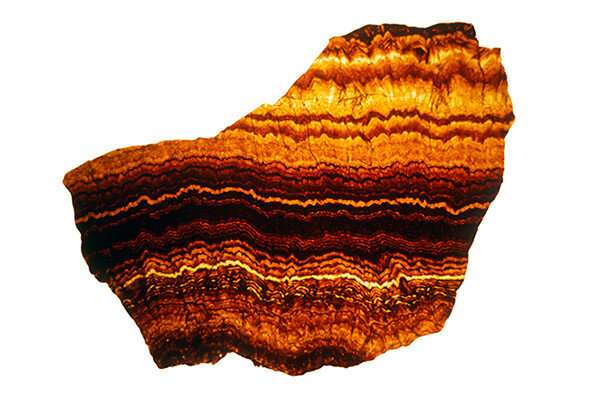Ancient rain gauge: New evidence links groundwater, climate changes in deep time

Changes in groundwater millions of years ago created alternating layers of vivid yellow and brown in the mineral sphalerite, and those variations align with movements in Earth's orbit that impacted climate in the deep past, Penn State scientists found.
The findings provide new evidence for how changes in climate influenced the planet's rainfall and groundwater, a process that scientists have not well documented, the researchers said.
"This study shows sphalerite banding can be used as a fingerprint of groundwater in the geological past," said Mingsong Li, assistant research professor of geosciences at Penn State. "Groundwater is crucial for understanding global sea level change, chemical weathering and landscape evolution, and this study presents a new idea to help discern the role of groundwater in the Earth system."
Increased precipitation influenced the colored banding in sphalerite samples from the Upper Mississippi Valley Ore Mineral District in the U.S. Midwest, the scientists said. More rainfall lead to oxygen-rich groundwater flowing to depths where the mineral formed, and the increased oxidation resulted in lighter yellow bands. Drier times yielded darker brown colors.
Using new dating technology, the scientists found these deposition patterns corresponded with changes in Earth's orbit over tens of thousands to hundreds of thousands of years, known as Milankovitch astronomical cycles.
These cycles refer to changes in the shape of Earth's orbit and variations in the tilt of its rotation that may have led to warmer, wetter conditions for periods from 299 million to 252 million years ago, when the sphalerite formed, the scientists said.
"What we are doing is marrying geochemical research on ores with what we know about astronomical cycles from very different research," said Hubert Barnes, distinguished professor emeritus at Penn State. "No one has ever made an attempt at this before."

The research builds on previous work that shows hydrothermal fluids that created ore deposits in modern day Iowa, Illinois and Wisconsin started as groundwater in the Appalachian Mountains. The water was heated by geothermal processes and picked up metals and solutes along it journey.
But during times of high precipitation, new sources of groundwater flowed to roughly 3,000 feet below the surface carrying higher oxygen levels and mixing with the hydrothermal fluids to create different colored bands in the sphalerite.
The researchers digitized a grayscale profile of the sphalerite from Wisconsin and analyzed the bands using new computer software that can detect periodic signals in the samples. They found distinct frequency peaks in the banding that correlate with the Milankovitch cycles.
The results—published today (Nov. 12) in the journal Geochemical Perspective Letters—could help explain changes in sea level during times in Earth's history when the planet was too warm for ice, the scientists said.
Changes in groundwater can have real impacts on sea level. If all groundwater drained into oceans today, sea level would rise more than 180 feet, according to the scientists.
Yet projections of long-term global mean sea level on times scales of hundreds to thousands of years often do not include the contributions of land water storage, the scientists said. The Intergovernmental Panel on Climate Change, for instance, considers water storage on land contribution to sea level rise to be small.
"This research opens a new way to evaluate climate control on groundwater activities linked to global water cycles," Li said. "This is the first direct evidence to show groundwater activities in the deep past."
More information: M. Li, H.L. Barnes. Orbitally forced sphalerite growth in the Upper Mississippi Valley District. Geochem. Persp. Let. (2019) 12, 18–22. DOI: 10.7185/geochemlet.1929
Provided by Pennsylvania State University





















